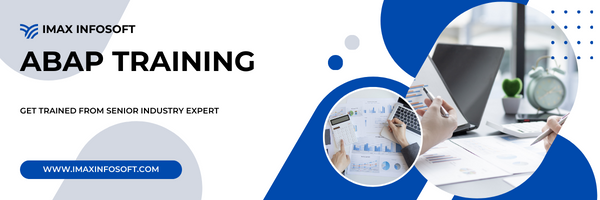SAP ABAP Training in Bangalore


At Imax we provide best SAP ABAP training in Bangalore Vijayanagar & BTM Layout. We provide both class room and online ABAP training. Candidates with technical background can take up SAP ABAP as career option. We have successfully trained thousands of candidates and they have got placed in various MNC’s. IT industry is looking for freshers as well as experienced candidates with in depth ABAP knowledge, more and more ABAP jobs are available for 2 – 3 plus years of experienced candidates. Our Project Internship program fulfill this criteria. Get in touch with us for your successful career growth.
Project Internship
We provide exclusive project internship (Implementation project training) which will help candidates to clear interviews under experience category. Join IMAX immediately and enhance your career. SAP ABAP training & project internship is provided by senior industry experts with 10 plus years of experience and currently working in different MNC’s
Reviews 4.8 ratings out of 5 from 5786 candidates for class room and online SAP ABAP training in Bangalore.
For Course Fees, Duration & Batches Please Call 9343565658 / 8073922743
- Purpose: ABAP is specifically designed for developing business applications and customizing SAP software according to specific business requirements. It allows developers to build new applications, modify existing functionalities, and integrate SAP systems with external systems.
- Data Processing: ABAP provides extensive capabilities for processing and manipulating data. It includes built-in data types, data structures, and a rich set of functions for data retrieval, transformation, and analysis.
- Modular Programming: ABAP supports modular programming through the use of function modules, subroutines, and methods. This allows developers to create reusable code components and enhance the maintainability and reusability of their applications.
- Database Access: ABAP provides database access capabilities to interact with the underlying database system. Developers can retrieve data from the database, perform modifications, and execute complex database queries using ABAP’s database-specific language elements.
- User Interface: ABAP enables the creation of user interfaces for SAP applications. It offers various tools and technologies for building user-friendly screens, reports, and forms. This includes the usage of screens and dialog programming, Web Dynpro for ABAP, and SAPUI5 for creating web-based interfaces.
- Integration: ABAP allows seamless integration of SAP systems with external systems and technologies. It supports various integration technologies like RFC (Remote Function Call), IDoc (Intermediate Document), BAPI (Business Application Programming Interface), and Web services to exchange data and interact with other systems.
- SAP Development Tools: ABAP development is typically done using the SAP development environment, known as the ABAP Workbench or ABAP Development Tools (ADT). ADT provides a comprehensive set of tools for developing, debugging, and maintaining ABAP programs, including code editors, debuggers, and transport management.
SAP ABAP provides a robust and flexible development platform for extending and customizing SAP applications. It allows businesses to adapt the SAP system to their specific needs, develop custom functionalities, and integrate SAP with other systems, enabling organizations to achieve greater efficiency and agility in their business processes.
Introduction to ERP
- What is ERP?
- Why we need ERP?
- Advantages of ERP
- Major ERP Packages
Introduction to SAP & R/3 Architecture
- What is SAP?
- History & Features of SAP
- SAP R/2 Architecture (Limitations of R/2 Architecture)
- SAP R/3 Architecture (Types of work processes)
- SAP R/3 Application Modules
- SAP Landscape
Introduction to ABAP/4
- What is ABAP?
- Logon to SAP Environment
- Transaction Codes
- Multitasking Commands
- Comments
- Errors
- ABAP/4 Editor ( SE38 )
- Steps for Creating a Program
- Elements in R/3 Screen
- Output Statements
- Operators in ABAP
- Data, Parameter & Constant Statements
- Data Types & Classification
- Data Objects & Classification
- Text Elements
- String Operations
- Control Statements
- Field strings
ABAP Dictionary
- ABAP Dictionary Introduction
- Data Dictionary Functions
- Data Dictionary Objects
- Data Base Tables
- Structures
- Views
- Data Elements
- Type Groups
- Domains
- Search helps
- Lock objects
- Primary Key And Foreign Key
- Table Maintenance Generator
Packages
- Creating a package
- Difference between local objects & packages
- Transferring local objects to packages
Variants
- Variants Introduction
- Creating variants in ABAP Editor & Data Dictionary
Message Classes
- Message Class Introduction
- Message types
- Calling message class in Report & Dialog programs
Reports
- Reports Introduction
- Selection screen Introduction
- Parameter Statement
- Select-options Statement
- Selection-screen Statement
- Screen table and its fields
- Dynamic screen modification by using Modify Id key
- Selection Screen Begin of block End of block
- Include Subscreen in Selection screen , Selection Screen Pushbutton
- Selection screen buttons on application toolbar
- Selection Screen begin of line End of line, Comments in Selection Screen
- Selection Screen Radio button, Check Box , List Box
- Selection Screen Select options no extension no intervals, Initial Values to Select Options
- Working with Events in Classical Report:- Initialization , At Selection-screen At Selection- Screen on Field, At Selection-Screen on block, At selection-screen on Radio button, At Selection-screen on Value Request, At selection-screen on help-request, At selection- screen Output,start-of-selection,end-of-selection,top-of-page,end-of-page
- Working with Events in interactive Report :- At line-selection, At user-command, At PFn, Top-of-page During Line selection
- Interactive Report Concepts: – Hide keyword, various system Defined Fields used, Hotspot, Get Cursor
Open SQL Statements
- Select
- Insert
- Modify
- Update
- Delete
Internal Tables
- Internal Tables Introduction , Internal table with header line / Without header line
- Declaring Internal Table , Types of internal table
- Populating Internal Table , Operations of Internal table
- Processing Internal Table
- Initializing Internal Tables
- Inner Joins And For All Entries
- Control Break Statements
Debugging Techniques
- Debugging Techniques Introduction
- Break-points (Static & Dynamic)
- Watch points
- Dynamically changing internal tables contents in Debugging Editor
- Options to step through the program in Debugging Editor
Modularization Techniques
- Modularization Techniques Introduction
- Includes
- Subroutines
- Passing Parameters to Subroutines
- Passing Tables to Subroutines
- Function Groups & Function Modules
Dialog / Module Pool Programming/ Transactions
- MPP Introduction
- Relationship between Screen, Flow Logic and Program
- Flow Logic Events
- Reading input Fields from Data Dictionary & Updating into Screen input Fields
- Working with List box Creating
- At exit Command
- Process Before Output (PBO)
- Process On Value Request (POV)
- Process On Help Request (POH)
- Dynamic Screens , On input, On chain-Input , on Request, On chain-Request
- Leave Screen
- Leave to Screen
- Call Screen
- Set Screen
- Processing of List from Transaction and Vice Versa
- Field / Group of field validation using Chain End chain Concept
- Elements in Screen Layout
- Table Controls , Status icon
- Step Loops
- Tabstrip Controls
- Subscreens
- Screen Elements Grouping & Modification Using Loop at screen concept
- Custom control , Creating screen ALV using Custom Control & Docking Control
Batch Data Communication
- BDC Introduction
- Recording
- BDC Methods :- Executing with Include Program & Executing custom Program without include program
- Call Transaction Method :- Uploading Excel file with File Path attached to input field
- Call Transaction Method:- Error Handling / Storing the errors in Data Dictionary Table or in excel format
- Session Method
- Scheduling Session Method in background
- Handling Table Controls in BDC
- Legacy System Migration Workbench
- Legacy System Migration Workbench :- Different Methods
- Flat file creation
- Uploading data
- File Handling
- Application Server
- Presentation Server
OOPS Concept (ABAP Objects)
- Object Oriented ABAP Overview
- Defining a Class
- Implementing a Class
- Working with methods & Attributes
- Method Parameters :- Importing, Changing, Exporting, Returning
- Events , Event Handlers, Registering Events
- Creating Objects & Working with Objects
- Singleton Class
- Inheritance
- Interface , Nesting Interfaces
- Abstract Class & Methods
- Final class & Final Methods
- Private Class
- Statics :- Static Attributes Class-Data , Static Methods Class-Methods
- Constructor
- Static Constructor
- Creating ABAP Object ALV Programs
- Factory Method
- Functional Methods
- Narrow Cast & Widening Cast
- Polymorphism
- Self-Referencing
- Create Global Class using the class Builder
- Creating Global class for Inheritance , Interface , Polymorphism , Final Methods , Abstract Methods
ALV Reports
- ALV Reports Introduction
- ALV through Function Modules
- ALV through ABAP Objects
- ALV List & Grid
- ALV for Line Color , Column color
- Edit ALV , Update the values in ALV
- Block ALV
- Hierarchical ALV
- List Tree ALV
- Screen Tree ALV
- Events in ALV
- Interactive ALV in List & Gird
- Interactive ALV in ABAP Objects
- Screen ALV drag & drop
- Adding buttons in ALV
- ALV Variants
- Checkbox In ALV
- Popup to Select in ALV
- Sorting & Page break in ALV
- Adding pictures to ALV
- Custom menu in ALV
- Saving layouts
- Event after line output
- Menu painter Interactive
SAP Scripts
- SAP Scripts Introduction
- Components of SAP Scripts
- Layout Set
- Standard Text
- Out Put Program
- Modifying Standard SAP Script Layouts
- Including Logos
- SAP Script Utilities – Upload / Download
Smart Forms
- Smart Forms Introduction
- Graphics Management
- Style Maintenance
- Paragraph Formats
- Character Formats
- Writing print program and designing layouts
Runtime Analysis & SQL Tracing
- ABAP Runtime Analysis :- SE30 / SAT
- SQL Trace :- ST05
- System Trace :- ST01
- ABAP Dump Analysis :- ST22
- Performance Trace : – ST12
- ABAP Extended Program Check :- SLIN
Cross Applications
- Introduction to Distributed Environment
- Introduction to Cross Applications
RFC
- Introduction to RFC
- Creating RFC Destination between 2 Systems
- Creating Remote Enabled Function Modules
- Creating program using Remote Enabled Function Modules
- Types Of RFC
- Create Programs for Different RFC Types
ALE
- ALE Basics
- Overview of Outbound & Inbound Process
- Configuration Steps
- Define logical systems
- Assign client to logical system
- RFC destination
- Customer distribution model
- Creating Ports
IDocs
- What is an Idoc?
- Types of Idocs
- Basic Idocs
- Extension Idocs
- Creating Idocs
- Message Types
- Assigning Idoc type to Message type
EDI
- EDI Basics
- Difference between ALE & EDI
- Overview of Outbound & Inbound Process
- Configuration Steps
- Port Creation
- Partner Profile Creation
BAPIs
- BAPI Overview
- Creation of BAPI
User Exits
- User Exits Overview
- Types of User Exits
- Field Exit
- Screen Exit
- Function Exit
- Menu Exit
BADIs
- BADIs Overview
- Defining a BADI
- Implementing a BADI
Miscellaneous Topics
- Correction & Transport request (CTS)
- Transport Organizer
- Work Bench Request
- Task Creation
- Release Objects
- SAP Memory & ABAP Memory
- Logical Database
- SD Flow
- MM Flow
VIJAYANAGAR
# 2948 E, 1st floor, Maruthi Arcade, Service Road, Above Karnataka Bank, Opp Maruthi Mandir, Vijayanagar, Bengaluru,
Karnataka - 560040
9343565658
BTM LAYOUT
# 7, 2nd floor, BTM 2nd stage,
Above James bond dry cleaner, near water tank bus stop,
Karnataka - 560076
8073922743
